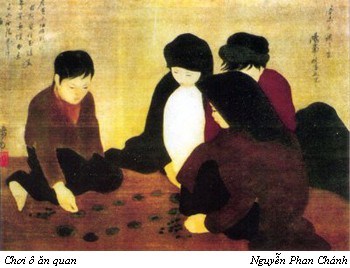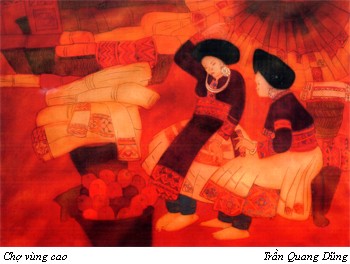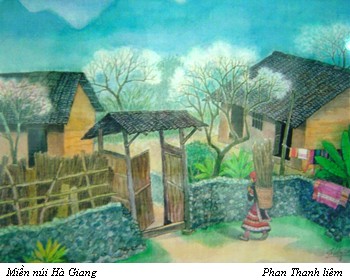(VOVworld)- Silk painting is a popular form of art in several Asian countries including China, Japan and Vietnam. With creativity and skillfulness, Vietnamese artists have created uniquely beautiful paintings featuring Vietnamese traditional culture. Throughout many turbulent times, the art of silk painting survives and grows together with the development of other Vietnamese arts. VOV’s reporter To Tuan tells us about the evolution of Vietnamese silk painting.
In the Vietnam History Museum, there are a few surviving silk paintings including portraits of famous personalities Nguyen Trai, and Phung Khac Khoan in the 15th and 16th centuries and some used for worshipping purposes. This proves that painting on silk appeared in Vietnam hundreds years ago and played an important role in Vietnamese folk arts. After a long period of developing techniques and styles, silk painting reached its peak of success during the 1930s, when some artists from the Indochina Fine Arts College combined the influence of Western arts with Oriental aesthetics to create unique silk paintings. The artists included painter Nguyen Phan Chanh whose famous silk paintings are “Rice washing”, “Count and Capture”, “Fortune Seeing”, and “Going to the field”. Many of his paintings depict Vietnamese girls, and rural Vietnam and have gained applause both inside and outside of Vietnam. Nguyen Phan Chanh was considered the one who discovered how to wash silk, which created a uniqueness and modern style for his Vietnamese silk paintings. He began to paint with light colors and used several layers to create the beauty behind a silk painting. By using contemporary colors, Vietnamese silk paintings are mysteriously beautiful due to their softness, elegance and a flexibility of style. Nguyen Thu, a famous silk painter says: "Ever since the 1950s, Vietnamese silk and lacquer paintings have become popular. In 1957, the paintings were exhibited around Europe and they captured great attention from foreign art lovers. Many foreigners came to Vietnam to buy silk paintings because of their uniqueness. When painting on silk, artists find it easy to express their feelings. The technique using water makes Vietnamese silk paintings softer, beautiful, romantic and unique".
 |
 |
Vietnamese silk paintings are elegant and soft featuring the beauty of the Vietnamese people’s soul and aesthetics that produce inspired views. Duc Hoang, a silk painter says: "Vietnamese silk paintings are different due to the technique of drawing on and washing the silk to ensure the colors are absorbed transparently into silk threats. Vietnamese silk paintings are also different from Chinese ones due to washing technique and the skills of Vietnamese artists who are influenced by Western arts. The main themes of Vietnamese silk paintings are people’s lives and that’s the reason they are different from Chinese ones".
 |
Silk paintings have helped to promote Vietnamese arts to the world as they are comparable with other silk paintings power houses including China and Japan. The topics for silk paintings cover people’s daily lives, portraits and also history, the struggles, production, objects and landscapes. In addition to silk paintings in traditional styles, many artists have also used new materials such as gold leaf, silver and tempera. Silk paintings have been promoted in several exhibitions inside and outside the country since 2006. These exhibitions show that the art of silk painting has been preserved and promoted as an important part of the Vietnamese arts scene.
To Tuan